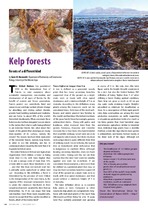| dc.contributor.author | Maneveldt, Gavin | |
| dc.date.accessioned | 2014-01-28T13:10:00Z | |
| dc.date.available | 2014-01-28T13:10:00Z | |
| dc.date.issued | 2011 | |
| dc.identifier.citation | Maneveldt, G.W. (2011). Kelp forests: forests of a different kind. Veld & Flora, 97(4): 168-170 | en_US |
| dc.identifier.issn | 0042-3203 | |
| dc.identifier.uri | http://hdl.handle.net/10566/977 | |
| dc.description.abstract | The United Nations (UN) Food and Agriculture Organization (FAO) defines a forest as being 'more than 0.5 ha with trees higher than 5 m and a canopy cover of more than 10%, or trees able to reach these thresholds in situ', ... and that this 'does not include land that is primarily under agricultural or urban land use'. According to this definition, a forest is 'determined by the presence of trees'. Critical to the interpretation of the term forest, is the capacity of the structural components (trees) to attain the minimum thresholds in their natural environment, unaided by direct human intervention. | en_US |
| dc.language.iso | en | en_US |
| dc.publisher | Botanical Society of South Africa | en_US |
| dc.rights | Copyright Botanical Society of South Africa. Permission has been given to reproduce this file in the Repository. | |
| dc.subject | Kelp | en_US |
| dc.subject | Forests | en_US |
| dc.subject | Sustainable management | en_US |
| dc.subject | Conservation | en_US |
| dc.title | Kelp forests: forests of a different kind | en_US |
| dc.type | Article | en_US |
| dc.privacy.showsubmitter | false | |
| dc.status.ispeerreviewed | false | |

